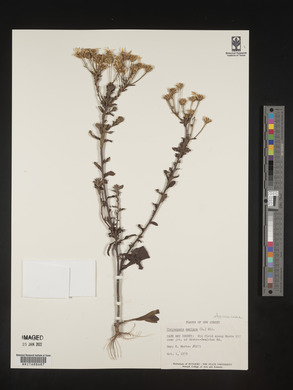Chrysopsis mariana
|
|
|
|
Family: Asteraceae
Maryland Golden-Aster
|
Biennials or short-lived perennials, 20-90 cm; fibrous-rooted or with short lateral rhizomes (new rosettes borne on fibrous roots or at ends of short lateral rhizomes or roots). Stems erect or ascending (often purplish), usually simple, sparsely to densely silky-sericeous (hairs sometimes long, twisting together at ends). Leaves: basal blades spatulate to oblanceolate, 15-250 × 4-40 mm, bases attenuate, margins obscurely dentate apically or entire, apices acute to obtuse, faces long-sericeous, glabrescent; cauline sessile, blades lanceolate to elliptic-oblong, 10-30 mm, reduced distally, margins entire or obscurely dentate, ciliate, apices acute, faces long-silky-sericeous or glabrate. Heads 1-50, usually in crowded subumbelliform arrays. Peduncles (from axils of distalmost cauline leaves or bracteoles) 0.5-5 cm, densely stipitate-glandular (glands yellow to brown); bracteoles 0-3, linear, stipitate-glandular. Involucres campanulate, 7-10 mm. Phyllaries in 4-5 series, erect, linear, unequal, 0.8-1.4 mm wide, apices acute, abaxial faces densely stipitate-glandular. Ray florets 10-22; laminae 8-11 × 2-3 mm. Disc florets 25-40; corollas 5-7 mm, lobes 0.5 mm. Cypselae (stramineous to purple) 2-3 mm, without ridges, shallowly ribbed or smooth, faces sparsely short-strigose; pappi in 2-3 series: outer of bristles 0.5-1 mm, inner of weakly to moderately clavate bristles 4-6 mm. 2n = 8, 16, 24, 32. Flowering Aug-Sep (n) to Nov-Dec (occasionally spring, Florida). Open to partially shaded, disturbed sandy and clay soils, open areas in pine and oak woods, scrub, natural rock outcrops, fields, roadside embankments; 0-700 m; Ala., Del., Fla., Ga., Ky., La., Md., Miss., N.J., N.Y., N.C., Ohio, Pa., R.I., S.C., Tenn., Tex., Va., W.Va. Chrysopsia mariana is present in the Coastal Plain, Piedmont, Appalachian Plateaus, Valley and Ridge, and Blue Ridge regions. All four ploidy levels occur in partially overlapping areas in Florida, but only the hexaploid occurs in other states (J. C. Semple and C. C. Chinnappa 1986). Larger involucres occur in plants with higher ploidy levels.
Fibrous-rooted perennial from a short, woody rhizome or branching caudex, 2-8 dm, loosely shaggy-villous with long, flexuous hairs when young, later often ±glabrate; lvs basally disposed, the lower oblanceolate to ovate, petiolate, to 18 נ3.5 cm (petiole included), generally denticulate; middle and upper lvs smaller, lanceolate to oblong or elliptic, sessile; heads in an often congested infl, nearly hemispheric, the disk 1-2 cm wide; invol and peduncles stipitate-glandular, the invol 7-10 mm; rays ca 13 to ca 21, ca 1 cm; achenes obovate, 3-5-nerved; 2n=8, 16, 24, 32, but only 24 with us. Woods and sandy places; s. N.Y. to s. O. and e. Ky., s. to Fla. and La. Aug.-Oct. (Heterotheca m.) Gleason, Henry A. & Cronquist, Arthur J. 1991. Manual of vascular plants of northeastern United States and adjacent Canada. lxxv + 910 pp. ©The New York Botanical Garden. All rights reserved. Used by permission. |























































































